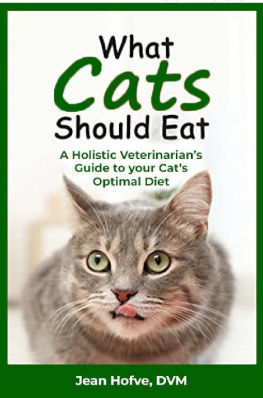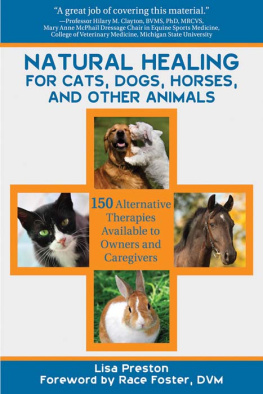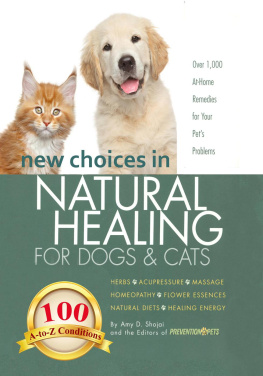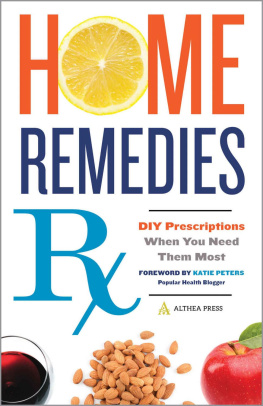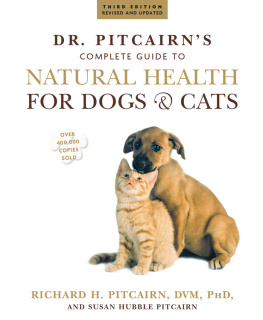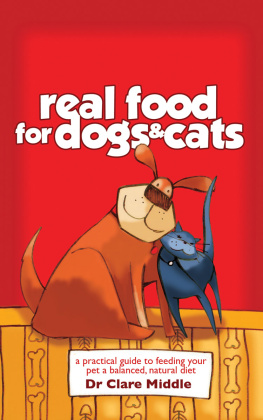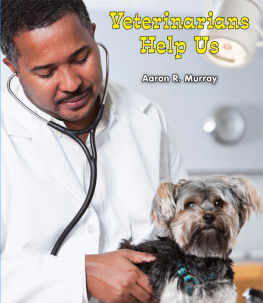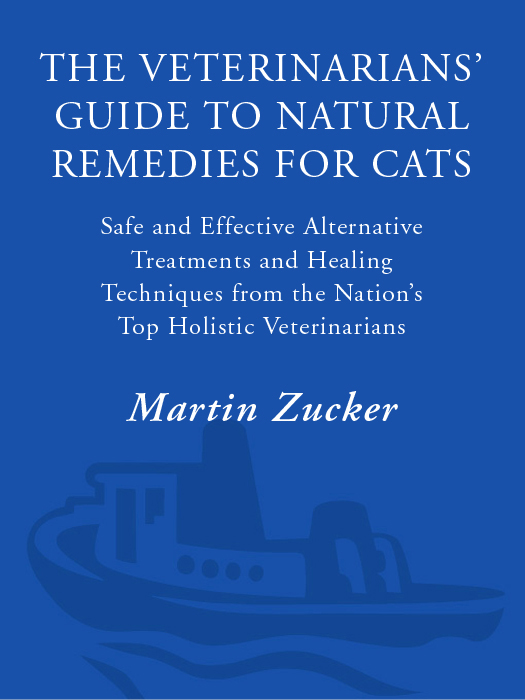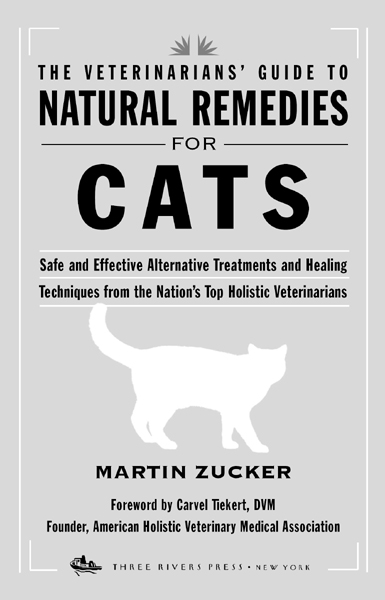Also by Martin Zucker
The Veterinarians Guide to
Natural Remedies for Dogs
To Carole and Chantale with a heart full of love.
Acknowledgments
I AM DEEPLY grateful to the many veterinarians who generously shared their vast and precious healing knowledge. Among them are true pioneers whose visions and methods are being widely applied today as more and more veterinarians realize that good medicine is not limited just to surgery and drugs, but is also about feeding quality food and using remedies that work the best and are the least invasive and the least toxic. Thanks to Nino Aloro, DVM; Wendell O. Belfield, DVM; Jan Bellows, DVM; Karen Bentley, DVM; Carolyn S. Blakey, DVM; Ron Carsten, DVM; Christina Chambreau, DVM; Roger DeHaan, DVM; Joseph Demers, DVM; Edmund R. Dorosz, DVM; Lynne M. Friday, DVM; Maria Glinski, DVM; Robert Goldstein, VMD; Stan Gorlitsky, DVM; Mark Haverkos, DVM; Shannon Hines, DVM; A. Greig Howie, DVM; Jody Kincaid, DVM; Charles Loops, DVM; Paul McCutcheon, DVM; Donna Starita Mehan, DVM; Alfred J. Plechner, DVM; William Pollak, DVM; Pedro Luis Rivera, DVM; Allen Schoen, DVM; Nancy Scanlan, DVM; Tejinder Sodhi, DVM; Carvel Tiekert, DVM; Thomas E. Van Cise, DVM; Pamela Wood-Krzeminski, DVM; Susan G. Wynn, DVM; Michele Yasson DVM; and Jean Hofve, DVM, for not only sharing her special cat knowledge, but also for reviewing the manuscript, diagnosing the flaws, and making winning suggestions.
I am particularly proud to have the voice of Norman Ralston, DVM, in this book. Ralston, a great holistic pioneer of veterinary medicine for more than fifty years, passed away in 1999. The holistic community will miss him very much.
Special thanks to PJ Dempsey, senior editor at Crown Publishing Group, whose friendship and sure handling of the editorial reins steered this book across the finish line. And to Bob Silverstein, of Quicksilver Books, a superb agent and caring friend.
Contents
Part One
Part Two
A.
B.
C.
Foreword
T HIS BOOK is filled with practical ideas and recommendations. If you use the information appropriately, you can create optimally healthy cats functioning at the very highest level of vitality that their genetic programming allows.
To do so, to achieve this desirable goal, you need to become an educated caregiver for your companion animal. Your role is critical. Above all, you must really get to know your cat. You need to become so familiar with your animal when it is healthy that you can recognize the first signs of illness right away and take remedial action promptly.
By knowing your animal, you need to regard it from a caregivers perspective. Look at its ears, at its teeth. Look between the toes. Look underneath. Anything that is abnormal is judged in the relationship to what is regarded as normal. And what may be normal for one animal may not be normal for another. Knowing your cat intimately brings you in closer contact and improves your mutual bonding, making the experience of being guardian that much richer.
By knowing your animal, you can also help usthe veterinariansdo our job as partners in helping your animal to better health. Just as you (and not somebody with an M.D. after his or her name) are ultimately responsible for your own health, so you are also ultimately responsible for the health of your cat. My role as veterinarian is as consultant and facilitator. I can make all the recommendations in the world, but if you dont do the work at home and make it a team effortboth to try the recommendations and to report responses accuratelyin many cases there wont be a proper resolution. You have to be involved.
You dont become healthy simply by taking a pill to get rid of a symptom or by undergoing an operation to eliminate something nasty in the body. These things dont create health. What counts the most is what you do over your lifetimeand the lifetime of your pet. Your actions create either chronic illness or chronic health. Unfortunately there are no magic bullets.
Most of the time, Western medicine is very good at handling acute care. It is also useful for diagnosis, and sometimes prognosis, and evaluating response to therapy. However, it doesnt have a good record for chronic disease. The problem is that the system is oriented to the elimination of symptoms. In many cases the symptom is the bodys best response to a negative stimulusfor example, if you have pain in a joint due to arthritis, the body is telling you to take it easy. A conventional drug may make the pain go away, but the problem (inflammation) is still there, and you havent helped the problem. Instead you may have aggravated it.
By comparison, when you use most natural therapies, if the pain goes away, its because you have altered the course of the disease, and the body no longer needs the symptom.
This book is unique. It contains recommendations and ideas based on the clinical experience of many veterinarians who routinely use natural therapies and who know what works and what doesnt work. Health writer Marty Zucker has done us all an important service by gathering this wealth of professional experience and shaping it into a practical book for cat owners. His concept is to give you different options so that if one particular approach for condition X doesnt work, a second or third one might. Each cat, just as each person, is a different creature, with a unique set of individual needs, individual biochemistry, and individual reactions. It is important to remember that. So if one option that you read about and try doesnt work, go to another one. Zucker gives you options that veterinarians have used in their own practices with good results. Given the individuality of all creatures, human or animal, this is a very practical idea. One remedy might work for your cat but not for your neighbors cat.
As you use this book keep one thing in mind. If you are dealing with what appears to be a minor problem, and your cat doesnt respond after you follow the advice you read here, dont wait until its too late and your cat is nearly dead before you see your veterinarian. Besides the fact that it could cost you a lot more money, there may be nothing that can be done at that point.
As I said earlier, know your animal. That will help you as you consider the remedies and concepts in this book or, for that matter, any therapy your veterinarian recommends. I cant emphasize this point enough. You need to be able to evaluate progress or lack of it. You do that by knowing your animal.
Good luck in your search for optimum wellness for you and your pet.
Carvel Tiekert, DVM, Bel Air, Maryland
Founder, American Holistic Veterinary Medical Association
Introduction
W HAT FOOD SHOULD I feed my cat?
What vitamins should I give my cat?
How do I give homeopathic medicines to my cat?
Is there a natural remedy I can use for my cats constant scratching?
Over the years many pet owners have asked me these types of questions because I am a health writer who has coauthored three previous books with veterinarians. The questions were posed by people looking for information on how to help their animals holistically. Most of them were unsure about how to start a natural healing program for their pets and were unable to get guidance from their veterinarians. Often they were concerned about veterinary prescriptions causing side effects and wanted to know how they could avoid medications. I am not a veterinarian, so I could speak only in general terms and share what I have learned from holistic veterinarians. Most of the time I would recommend that they consult with a holistic practitioner.


